|
Hambantota in the forefront:
President's influence spurs development
By Shirajiv SIRIMANE
|
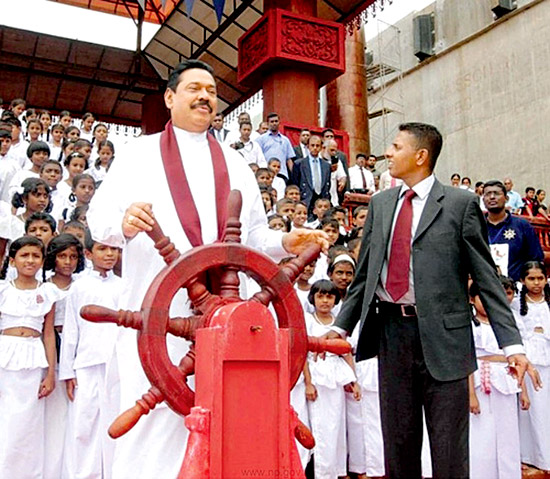
President Mahinda Rajapaksa also spearheaded several other
development projects, especially in the North and the East, that
were stalled for several decades, ushering in prosperity to the
nation and taking the country towards
|
Sri Lanka's development was stalled for many decades as the country's
former Heads of State did not want to compromise their popularity by
taking controversial decisions and risk re-election.
Whenever a controversy arose during a major development project, the
leaders bowed down to various elements and decided to skip the project.
This happened for decades, resulting in many infrastructure projects
being neglected.
This also resulted in foreign investors shying away from Sri Lanka,
resulting in the loss of foreign direct investments.
One leader who observed this negative scenario from his youth was
Mahinda Rajapaksa. He saw and experienced how successive governments
cold-shouldered the Hambantota Port project which was first proposed by
D.A. Rajapaksa in the 1950s.
Various excuses were put forward, resulting in the project being
delayed by nearly 50 years. The irony was that the construction of the
port would not have had any negative impact on society.
President Mahinda Rajapaksa, who was selected the fifth most
influential leader in the world last week, got the project moving and
the first phase is now completed. He got the much needed funds, got
China Harbour Construction Company involved and the project was
completed ahead of time.
The oil tank farm and bunkering facility would be ready by June and
ships would arrive, heralding a new era for this under-privileged
province which has been looked down for centuries.
The bunkering facility will comprise 14 tanks. Eight tanks will be
used to provide oil for ships while three will be used to store LP gas.
The rest of the tanks will be used to provide oil for aircraft to meet
the demand created after the opening of the Mattala International
Airport by the end of next year.
The project will cost USD 76,581,774 and China Huanqiu Contracting
and Engineering Corporation Works would be the contractor.

President Mahinda Rajapaksa inspecting a development project |
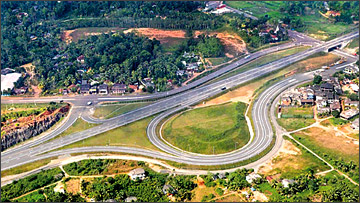
Matara highway |
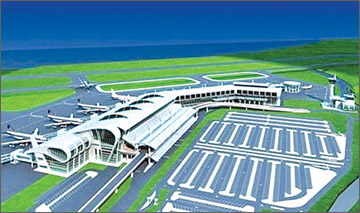
The Mattala Airport project |
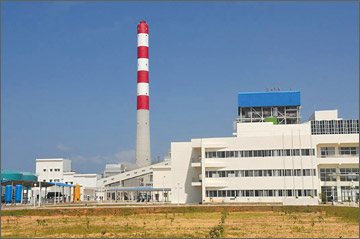
Norochcholai project |
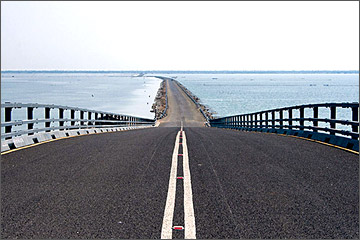 |
| Sangupiddy bridge linking
Jaffna with Pooneryn |
The tank farm will include two 10,000 mt tanks, which will hold a
combined 20,000 mt of aviation fuel and three tanks to store 7,000 mt of
LPG. The rest of the tank farm will include tanks of various sizes,
which will hold a total of over 55,000 mt of bunker fuel.
Currently, the only onshore bunker fuel terminal in the country, at
Port Colombo, consists of 12 tanks that can hold a combined 33,000 mt of
bunker fuel.
With four other international harbours simultaneously being developed
in line with the Mahinda Chinthana Sri Lanka was slowly but surely
transforming itself to a maritime hub for the region.
The Mahinda Chinthana was clear on the ending of the conflict and
that was achieved on May 19, 2009 after a 30-year period.
President Rajapaksa kept this promise as well.
Airlines flying to Sri Lanka were carrying additional fuel and were
also taking a risk in doing so. Due to this factor, flying to Sri Lanka
is considered a costly affair and some airlines even went to the extent
of taking this additional expenditure from the passenger.
More airlines want to include Sri Lanka on their international
destination map while others want to add additional frequencies.
However, heavy traffic in the Colombo airport has put a check to these
plans.
A second airport for the island was being talked about for nearly
three decades and venues that were proposed included Matugama,
Kurunegala and Embilipitiya.
President Rajapaksa fulfilled the crying need for a second
international airport by building it at Mattala.
Longest runway
Its first stage would include the building of Sri Lanka's longest
runway (3,500m) and parking bay for 10 aircraft, two aero bridges and
other related buildings.
Under the first phase the airport hopes to cater to one million
passengers while the cargo movement is expected to be 45,000 mt per
annum. A rail link from the airport to the Hambantota harbour too is
proposed.
Minister of Power and Energy, Patali Champika Ranawaka said that the
Ceylon Electricity Board (CEB) had committed two major blunders; first
relying only on hydro power and second, depending on thermal power.
Whenever there was a drought, the country was in pitch darkness and when
fuel prices rose to record highs, the CEB had to pay through its nose.
Due to these factors, the CEB decided to bank on other power sources.
One solution was the construction of the Norochcholai power plant.
However, no leader wanted to go ahead with the project as it was too
controversial. Being the fifth most influential leader in the world, (at
the time of writing) President Rajapaksa got the project moving and the
first phase is now open.
The first stage of the Norochcholai project would generate 300
megawatts to the national grid and the investment for the total project
would be Rs. 155 billion. It would also be in a position to generate a
unit of electricity at Rs. 4.75.
Hydro power project
The Minister said that for 15 years, not a single major hydro power
project was constructed with the Upper Kotmale project being stalled for
nearly 20 years. Once again, it was President Rajapaksa who got the
project moving and the first phase is to be completed by the end of the
year.
The President negotiated with Japan International Corporate Agency
and secured USD 297 million on a 30-year long-term credit, ironing out
the other gray area of the project. The Government invested USD 87
million, making the project a reality.
Japanese and Sri Lankan engineers created a special 25 hectare
reservoir across the Kotmale Oya and a 35.5 metre tall and 180 metre
long dam was built across it. This project would generate 150 megawatts.
The Galle-Matara Highway and Colombo-Katunayake Highway too were in
the pipeline for many years. The Colombo-Matara highway, 126 km (78.2
mile), would take a passenger to Matara in less than two hours. It would
also have 11 access points starting from Kottawa.
A passenger can take the new highway and reach the airport in 45
minutes. The length of the expressway would be around 25 kilometres
starting from the New Kelani Bridge and ending at the Airport Access
Road at Katunayake. The total estimated cost for the project is USD 292
million.
The proposed Colombo-Katunayake Expressway will provide a high-speed
road link between the Colombo City and the Free Trade Zone and the
Bandaranaike International Airport at Katunayake.
The expressway, with four lane carriageways, will include five
interchanges at the new Kelani Bridge, Peliyagoda, Kerawalapitiya
(connect with Outer Circular Highway), Ja-Ela and Katunayake.The
expressway is expected to be completed in 39 months with financial
assistance granted by the Chinese Government.
President Rajapaksa has also spearheaded several other development
projects especially in the North and the East that were stalled for
several decades, ushering in prosperity to the nation and taking the
country towards becoming the Wonder of Asia.
|

